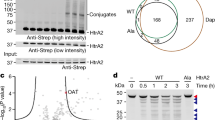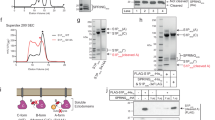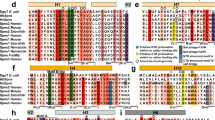Abstract
Site-1 protease (S1P) is a subtilisin-related enzyme that cleaves sterol regulatory element-binding proteins (SREBPs) in the lumen of endoplasmic reticulum, thereby initiating the release of transcriptionally active NH2-terminal fragments of SREBPs from membranes. In the experiments reported here, we localized the human S1P gene to chromosome 16q24 by fluorescent in situ hybridization and radiation-hybrid mapping, and determined its genomic structure. This gene is more than 60 kb long and contains 23 exons and 22 introns. Its transcription-initiation site within exon 1 is separate from the initiation codon in exon 2. Analysis of the exon/intron structure revealed that the S1P gene consists of a mosaic of functional units: exon 1 encodes the 5′ non-translated region; exon 2 encodes the NH2-terminal signal sequence; and exons 2 and 3 encode the pro-peptide sequence that is released when S1P is self-activated by intramolecular cleavage. Exons 5–10 encode the subtilisin-homology domain that is critical for catalytic activity, and exon 23 encodes the transmembrane region. Analysis of the putative promoter region revealed a highly G/C-rich region containing a binding site for ADD1/SREBP-1, as well as Sp1 and AP2 sites. Therefore, expression of the S1P gene may be under the control of SREBP-1, a key regulator of the expression of genes essential for intracellular lipid metabolism. Our data establish a basis for investigations to detect molecular variants in this gene that may alter levels of plasma lipoproteins and/or otherwise disrupt intracellular lipid metabolism.
Similar content being viewed by others
Log in or create a free account to read this content
Gain free access to this article, as well as selected content from this journal and more on nature.com
or
Author information
Authors and Affiliations
Additional information
Received: December 27, 1999 / Accepted: March 21, 2000
Rights and permissions
About this article
Cite this article
Nakajima, T., Iwaki, K., Kodama, T. et al. Genomic structure and chromosomal mapping of the human Site-1 protease (S1P) gene. J Hum Genet 45, 212–217 (2000). https://doi.org/10.1007/s100380070029
Published:
Issue date:
DOI: https://doi.org/10.1007/s100380070029
This article is cited by
-
A transversal approach to predict gene product networks from ontology-based similarity
BMC Bioinformatics (2007)



